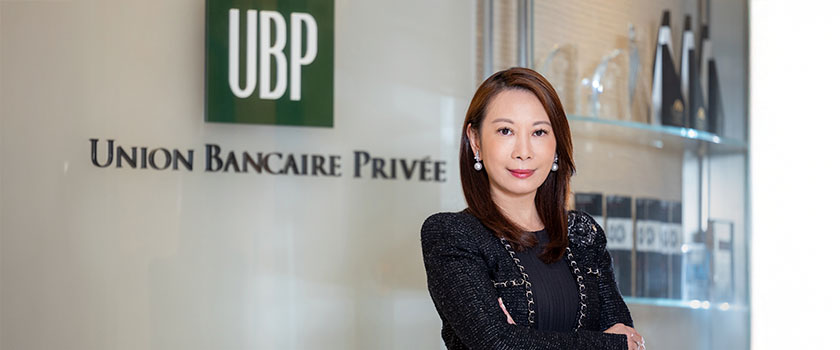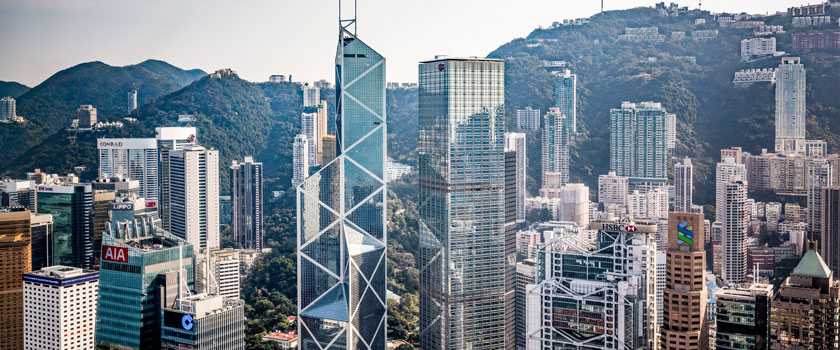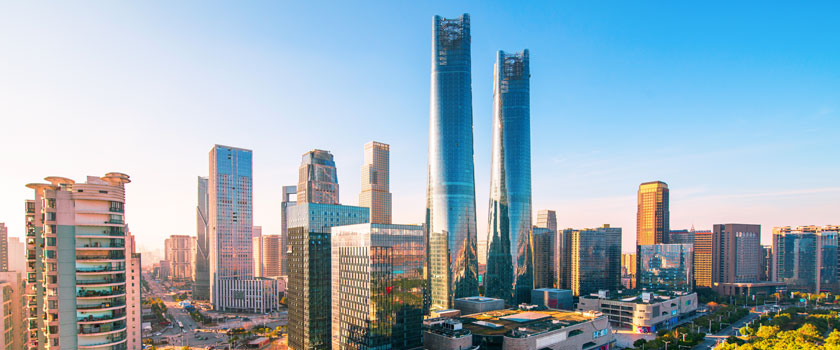GDP growth bottomed in Q2 and should recover around 5.0% y/y in H2 2022. The July Politburo meeting confirmed this, stressing “stability” and dropping the 5.5% GDP growth target. We maintain our forecast for 2022 unchanged at 3.7%.
Key takeaways
-
Although consumption and manufacturing rebounded in June, the slump in the housing sector will lead to a more modest pace of recovery in H2 2022. Careful policy coordination is needed to mitigate risks.
- China will deliver policy support as other global central banks hike rates. Monetary policy should remain accommodative, without flooding the market with liquidity. Fiscal policy will provide stronger impetus from Q4 2022 onwards.
- We have become more constructive on Chinese equities, especially on a relative basis. However, we remain cautious in the high-yield space and are wary of potential spill over risks to higher quality names and Chinese bank AT1 bonds.
Q2 will mark the weakest quarter of growth in 2022
China has once again captured the attention of investors seeking shelter from unprecedented global policy tightening. This is understandable, as the country was first in, first out of the Covid pandemic and remains ahead of the curve in terms of its business cycle. The United States (US) Federal Reserve (Fed) hiked interest rates by 75 basis points in July, as expected. Fed Chairman Jerome Powell citied the need to address inflation which remains “much too high” but also acknowledged that the economy is facing some downside pressures. In contrast, China is exiting a period of economic weakness and is adding stimulus, following aggressive policy tightening in 2021 under the guise of the deleveraging campaign. The tail end of the deleveraging campaign overlapped with strict lockdowns in several Chinese cities during April-May (approximately 25% of total GDP). As a result, China’s economy experienced its worst period of growth during April-May. GDP contracted by -2.6% SA q/q in Q2 2022, down from 1.3% SA q/q in Q1 2022. In interannual terms, GDP came in flat, expanding by 0.4% y/y and decelerating significantly from 4.8% y/y in Q1 2022. We had forecasted that GDP would decline -1.0% y/y (-3.0% q/q) in Q2 2022, but a recovery in June activity indicators exerted upside risks. In essence, domestic consumption proved to be more resilient than expected, while a pick-up in exports promoted manufacturing activity.
Retail sales rebounded to 3.1% y/y in June, reversing a sharp -6.7% y/y contraction in May. The recovery was most conspicuous for services. For example, the official non-Manufacturing PMI soared to 54.7 in June, while the Caixin Services PMI increased to 54.5. Both measures jumped the most since March 2020, favoured by pent-up demand. Going forward, demand for both services and goods should normalise in July. The reintroduction of lockdown measures in Anhui and Wuhan, albeit more restrained ones, will also dampen consumption. In addition, inflation is expected to increase gradually and may exceed PBOC’s 3.0% target during Q3 2022. Most of this increase can be traced back to cost-push inflation – namely higher imported food and energy prices. A normalisation in the domestic pork supply chain following two years of contraction should also play a role in higher inflation through base effects.
Industrial production also bounced back more strongly in June, reaching 3.9% y/y compared to 0.7% y/y in May. Much of this recovery can be traced back to a backlog in export orders, with exports in USD terms expanding 17.9% y/y in June. This should not be interpreted as a sign of robust external demand, but rather quite the opposite. The external environment will turn less supportive in H2 2022, as the probability of recession in the Eurozone and the US will increase in coming months. Additionally, other Asian exporters have regained back their market share vis-à-vis China, following stronger depreciations against the USD.
In sum, we expect that activity indicators will return to trend in July, with Q2 2022 marking the weakest quarter. Activity will not rally exponentially from here onwards. Instead, we expect that GDP growth will stabilise around 5.0% y/y in H2 2022. For China to meet its official growth target of 5.5% in 2022, GDP would have to rebound to 8.0% on average in the remainder of the year, a scenario that seems less likely at this juncture. Therefore, we see fewer upside risks to our 2022 GDP growth forecast of 3.7%. We have also kept our 2023 forecast unchanged at 4.5%.
Housing slump underpins slower recovery in H2 2022
Most of the downside came from the investment side. Fixed asset investments (FAI) slowed to 6.1% YTD y/y in June, down from 6.2% YTD y/y in May. This was led by a decline in property investment to -5.4% YTD y/y, but almost all the risk was concentrated in the residential sector. Residential property sales declined by a whopping -31.8% YTD y/y in June, while the number of new construction projects also plummeted sharply to -34.4% YTD y/y. Against this backdrop, the ability of real estate developers to complete projects has come to the fore. Home buyers from 300 real estate projects in 91 cities have stopped servicing their mortgages as of July. The “mortgage revolt” followed reports that several developers had ran out of cash after tapping escrow accounts containing the proceeds from presold units, to meet debt repayments.
With that being said, we do not expect that China’s “mortgage revolt” will turn into a source of systemic fragility. Contagion risks have spread rapidly but the value of mortgages impacted only represents USD 300 billion or around 0.6% of total bank liabilities. Additionally, Chinese households are solvent (household debt remains low at 62% of GDP) but have chosen not to make these repayments until their homes are delivered. Political factors are also noteworthy – Henan accounts for 35% of total affected projects and this is the stronghold of Premier Li Keqiang. Although the sector does not constitute a systemic risk, it will remain sluggish in 2022 for several reasons:
- Low starting point: Current conditions are very contractionary, so it may take many quarters before real estate investment turns positive again.
- Muted sentiment: China’s “mortgage revolt” represents a low point in domestic sentiment. This has been made worse by the “zero-Covid” policy, as citywide lockdowns prevent households from making investment decisions. With transaction volumes at record lows, home prices in China’s 70 largest cities declined for a third straight month to -1.3% y/y in June.
- Default concerns: It is estimated that approximately 50% of developer’s cash flows are derived from the sale of pre-sold units. Policymakers are in a bit of a conundrum, as developers will face difficulties accessing working capital to complete projects while sentiment remains subdued; but sentiment will only improve once these projects are completed.
Going forward, we expect that policymakers will resort to targeted measures to ameliorate risks. State-owned banks have been asked to extend credit to developers in distress, while local governments have announced plans to create a bailout fund to take over the completion of impacted developments. The priority is very clear: the government will guarantee that hardworking middle-class families get handed over the homes that they have already paid for.
Politburo meeting puts emphasis on stability
We estimate that a 30% slump in the housing sector could cost China about 1 percentage points of GDP growth in 2022. This is due to the sector’s outsized weight in the overall economy (approximately 25% of GDP). Such drag on activity is not negligible and requires careful policy coordination. Additionally, the July Politburo meeting was decidedly not hawkish and made no reference to the official 5.5% growth target. Instead, the Politburo meeting underscored “stability” amid a more “complex external environment” and pledged to uphold “Dynamic Zero-Covid”. That means that the policy stance should remain accommodative, even as the Fed hikes rates more aggressively in H2 2022, but Beijing will not flood the system with excess liquidity to pursue growth at all costs.
In terms of monetary policy, it will be more of the same. Easing has been notably incremental, with the People’s Bank of China (PBOC) refraining from deploying broad-based rate cuts since December 2021. PBOC is mindful about outflows while the policy differential with the US remains wide. Furthermore, liquidity remains ample in China, with the Shanghai Interbank Offered Rate (SHIBOR) declining below China’s interest rate corridor in July. The problem is sentiment not liquidity. What we might see instead is more targeted support for the housing sector. On May 17, the PBOC trimmed the 5-year Loan Prime Rate (LPR) by 15 bp to 4.45%. The 5-year LPR is used to price mortgages while the 1-year is used to price loans. Previously, the PBOC had also cut the lower-bound range of mortgage interest rates for first-time homeowners to 4.4% from 4.6%. Finally, PBOC will continue to boost aggregate demand via faster M2 and credit growth.
In terms of fiscal policy, the Politburo meeting put most of the emphasis on implementation of measures that have already been rolled out. On May 23, China’s State Council rolled out a 33-point plan of support measures to stabilise the economy. The plan included more than CNY 140 Bn (USD 21 Bn) in extra tax rebates, increasing the total amount to CNY 2.64 trillion (around 2.5% of GDP). It also introduced macroprudential tools, for example allowing companies to defer social and insurance payments until the end of 2022. Infrastructure spending will also play a prominent role from Q4 2022 onwards. The Ministry of Finance will front-load CNY 1.5 trillion of the Local Government Special Bond (LGSB) quota for 2023 to Q4 2022. LGSBs are used to finance infrastructure. The government has also floated the idea of a CNY 500 billion infrastructure fund, to be launched in late Q3.
Implications for investors
Sustained policy support and an improving macroeconomic environment are supportive of a gradual recovery in Chinese equities. Indeed, we remain constructive and expect that the sector will likely outperform global equities on a relative basis in 2022. As a result, we pivoted to a neutral-to-slightly-overweight position in our global asset allocation in June. That does not preclude potential downside risks, which are predominantly concentrated around China’s “Dynamic Zero-Covid” strategy. Therefore, we prefer good quality companies in sectors that are well aligned with policy priorities under the 14th Five-Year Plan.
In contrast, Fixed Income investors should remain cautious. Chinese High-Yield spreads should remain wide throughout 2022, skewed by real estate developers. Moreover, we expect potential spill over risks to higher quality names within this sector as well as Chinese banks. In addition, Chinese bank AT1s may be impacted, as we have already seen in Henan, given that they are also trading tight compared to global peers.
Lastly, the policy differential with the US will remain wide in H2 2022. Compounded with a narrowing of the trade surplus, as external demand weakness in the coming months. This could exert depreciatory pressures on the currency towards USDCNY 6.90-6.95 by year-end.








